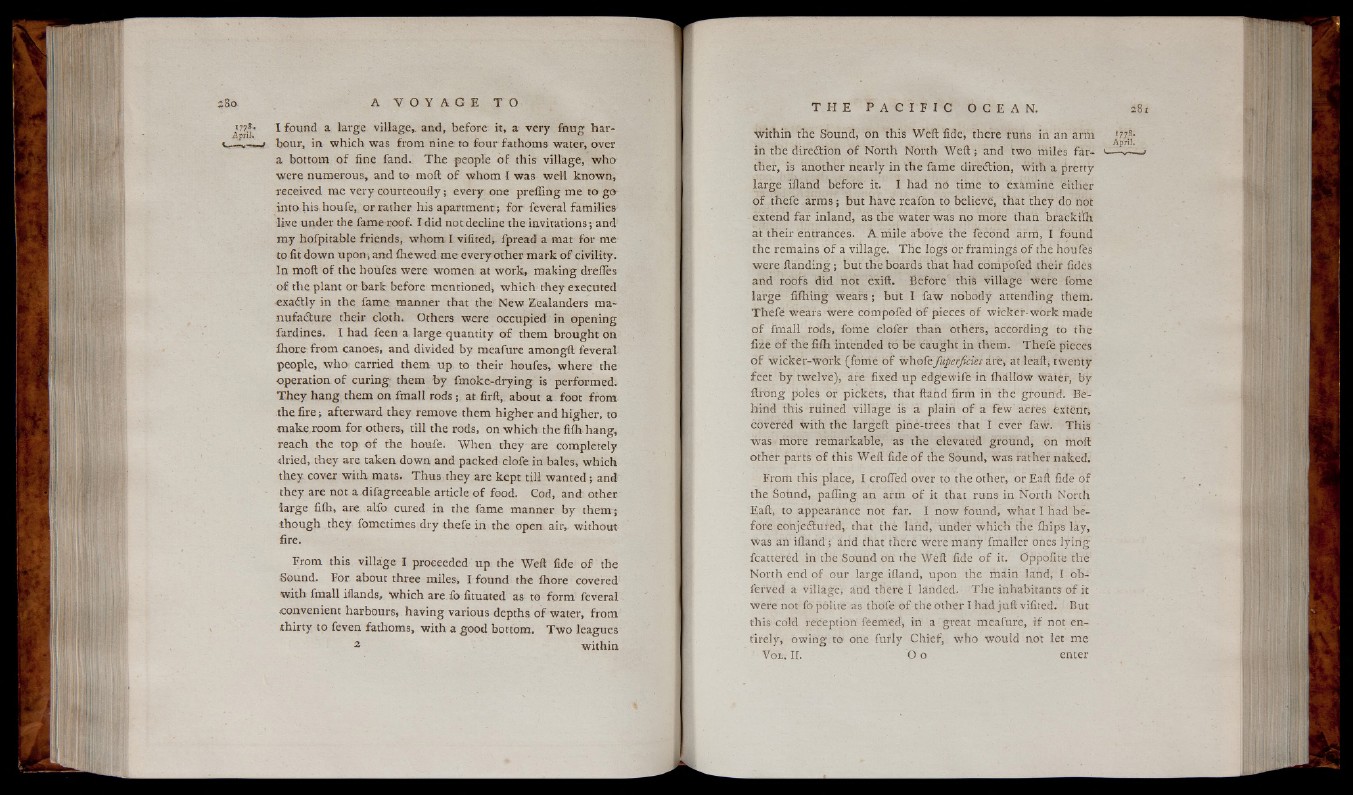
I found a targe village,, and, before it, a ve ry fn u g h a r bour,
in which was from nine to four fathoms water, over
a bottom o f fine fand. T h e people o f this villa ge , who
were numerous, and to moil o f whom I was w e ll known,
received me ve ry courteoufly; every one preffing me to go
into his houfe, or rather his apartment; fo r feveral families
■live under the fame roof. I did not decline the invitations; and
m y hofpitable friends, whom I vifited, fpread a mat fo r me
to fit down upon, and ihewed m e every other ma rk o f civility.
In moft o f the houfes were: women at work, making drefies
o f the plant or bark before mentioned, w hich they executed
exadlly in the fame manner that the New Zealanders manufacture
their cloth. Others were occupied in opening
fardines. I had feen a large quantity o f them brought on
fhore from canoes, and divided by meafure amongft feveral
people, w ho carried them u p to their houfes, where the
operation o f cu r in g them b y fmoke-drying is performed.
T h e y han g them on fmall rods ; at firft, about a foot from
the fire; afterward they remove them higher and higher, to
m a k e room fo r others, till the rods, on w hich the fifli hang,
reach the top o f the houfe. When th e y are completely
dried, they are taken down and packed clofe in bales, which
they cover w ith mats. T hus they are kept till w an ted ; and
they are not a difagreeable article o f food. Cod, and other
la rge fiih, are alfo cured in the fame manner b y them;
th o u gh they fometimes dry thefe in the open air, without
fire.
From this village I proceeded up the Weft fide o f the
Sound. For about three miles, I found the fhore covered
w ith fmall iflands, which are fo fituated as to form feveral
convenient harbours, ha vin g various depths o f water, from
th irty to feven fathoms, with a good bottom. T w o leagues
2 with in
w ithin the Sound, on this Weft fide, there runs in an arm
in the direction o f North North Weft ; and two miles farther,
is another nearly in the fame direction, with a pretty
large ifland before it. I had no time to examine either
o f théfe arms ; but have reafon to believe, that they do not
extend fa r inland, as thè water was no more than bracki'fh
at their entrances. A mile above the fécond arm, I found
the remains o f a village. T h e logs or framings o f the houfes
were Handing ; but the boards that had compofed their fides
arid roofs did not exift. Before this v illa g e were fome
la rge filhirig wears ; but I faw nobody attending them.
T he fë wears were compofed o f pieces o f wicker-work made
o f fmall rods, fome clofer than others, according to the
fize o f the fifh intended to be caught in them. Thefe pieces
o f Wicker-Work (feme o f whoftfuperjicies are, at leali, twenty
feet b y twelve), are fixed up edgewilh in ihallbw water, by
ftfóng poles or pickets, that ftafid firm in the grourid. Behind
this ruined villa ge is a plain o f a few acres extent;
covered with the largeft pine-trees that I ever faw. This
was more remarkable, as the elevated ground, on moft
other parts o f this Weft fide o f the Sound, was rather naked.
From this place, Ì croifed over to the other, or Eaft fide o f
the Sound, palling an arm o f it that runs in North North
Eaft, to appearance not far. I now found, what I had before
eonjedturëd, that the land, under which the ¿hips lày,
was an ifland ; and that there were many fmaller ones ly in g
fcatterëd in the Sound on the Wéffi fide o f it. Oppofite thé
North end o f our large ifland, upon the main land, I ob-
fefved a village, and there I landed. T h e inhabitants o f it
were not fo po liti as thofe o f the other I had juft vifited. But
this cold reception féemed, in a great meafure, i f not entirely,
owin g to one furiy Chief, w ho would not let me
Vol. II. O o enter